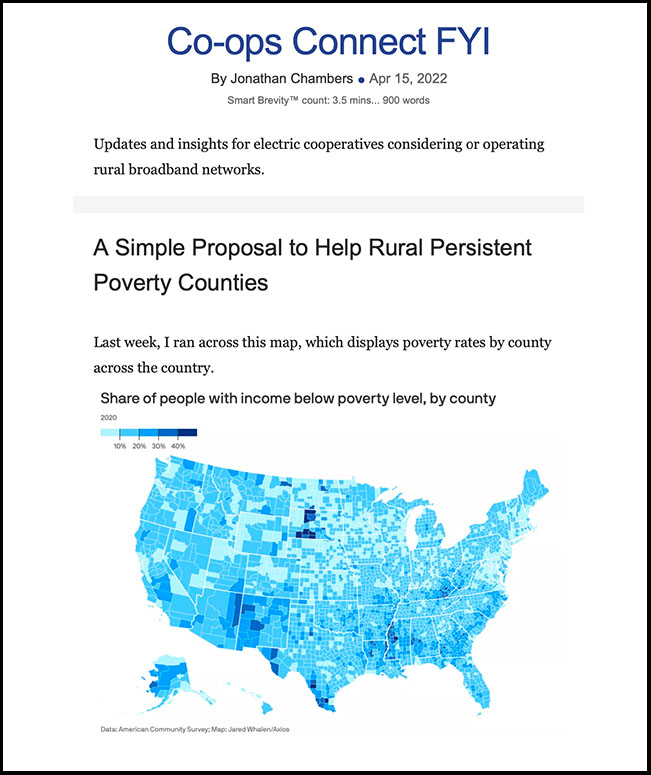A Simple Proposal to Help Rural Persistent Poverty Counties
April 15, 2022
- A persistent poverty county is one which has had a poverty rate of 20% or greater for at least 30 years.
- There are 595 such counties in the country.
Why it matters:
Unsurprisingly, if you compare the most impoverished counties in the country with counties unserved by broadband, there is a strong correlation.
So, what can we do about it?
The Case for Broadband to Impact Persistent Poverty
I’m not suggesting that broadband will lift people out of poverty.
I am suggesting that without affordable, high-quality broadband, these persistent poverty counties have no chance.
The bottom line: As a nation currently spending upwards of $100 billion in public funds on broadband, helping these counties is the least we can do.
How? Start here:
The Affordable Connectivity Program contains a provision that offers broadband providers in high-cost areas $75 per subscriber.
Yes, but:
The provision has not yet been put into practice.
It is being considered in an FCC regulatory proceeding, which may not be completed for quite some time.
(See Wireline Competition Bureau Seeks Comment on the Implementation of the Affordable Connectivity Program, WC Docket No. 21-450, Public Notice, DA 21-1453 (rel. Nov. 18, 2021) here)
Go deeper:
More troubling, the statutory language is oriented to the poverty of the broadband provider rather than the poverty of the people who could receive the benefit.
For a household to receive the benefit, the service provider must show “particularized economic hardship to the provider such that the provider may not be able to maintain the operation” of the broadband network.
The big picture:The FCC, in interpreting this language, likely will award the enhanced ACP benefit only to households in high-cost areas where the provider is failing, rather than where the community has faced persistent poverty.
Let’s try to replace the convoluted and nonsensical statutory language with something that is simple and commonsensical.
A Better Approach in Two Steps
Don’t complicate it:
1. The FCC should use one of its cost models (A-CAM or CAM) to determine which counties of the country are high-cost.
2. The FCC should provide a $75 monthly subsidy through the ACP to households in high-cost persistent poverty counties.
That’s it. That’s the whole proposal.The next question: How could this proposal turn into a funding program?
One of two ways:
1. By the FCC acting in response to a petition for rulemaking or on its own motion.
2. By Congressional action, which can come in the form of an amendment to the ACP in an appropriations bill.
How Can You Help?
Again, two steps:
1. Determine whether your service territory includes persistent poverty.
2. Determine whether your Senator or Representative sits on a committee with relevant jurisdiction.
What's next:While any member of Congress can introduce legislation or contact the FCC, the committees with the clearest ability to act on spending programs are the appropriations committees.
Annual appropriations for the FCC falls under the jurisdiction of the Appropriations Subcommittee for Financial Services and General Government.
The Chairman and Ranking Republican Member of that House Subcommittee are Congressmen Mike Quigley (D-IL 5th District) and Steve Womack (R-AR 3rd District).
The Chairman and Ranking Republican Member of the Senate Subcommittee are Senators Chris Van Hollen (D-MD) and Cindy Hyde-Smith (R-MS).
The other members of the subcommittees are:
House Matt Cartwright (D-PA 8th District)
Sanford Bishop Jr. (D-GA 2nd District)
Mark Pocan (D-WI 2nd District)
Brenda Lawrence (D-MI 14th District)
Norma J. Torres (D-CA 35th District)
Ann Kirkpatrick (D-AZ 2nd District)
Mark Amodei (R-NV 2nd District)
Chris Stewart (R-UT 2nd District)
Dave Joyce (R-OH 14th District)
SenateChristopher Coons (D-DE)
Richard Durbin (D-IL)
Joe Manchin (D-WV)
Jerry Moran (R-KS)
John Boozman (R-AR)
John Kennedy (R-LA)
The Bottom Line
There’s a lot of poverty in the parts of the country represented by the politicians who sit on Appropriations Committees.
By the numbers:
Of the 82 counties in Mississippi, 56 are persistent poverty counties.
Of the 64 parishes in Louisiana, 44 are persistent poverty parishes.
Of the counties covered entirely by Majority Whip Jim Clyburn’s district in South Carolina, all seven are persistent poverty counties.
Any one of the Representatives or Senators on this list could make this proposal a reality.
If you are a co-op broadband provider represented by one of the Representatives or Senators on this list and want to lend a hand, let me know.
I’ll leave you with this:
This evening is the start of Passover. We open the door to the Passover Seder and proclaim, “Let all who are hungry come and eat.” During Seder, Jews repeat the phrase, “We were slaves to Pharaoh in the land of Egypt.”
Whatever our current status in life, we recognize that in our history we have only ever been a generation or two removed from hardship and suffering.
Loss is our starting point. We know what it is like to lose most everything. We know what it is like to rebuild.
This is a modest and meaningful proposal. Let’s get to work.
